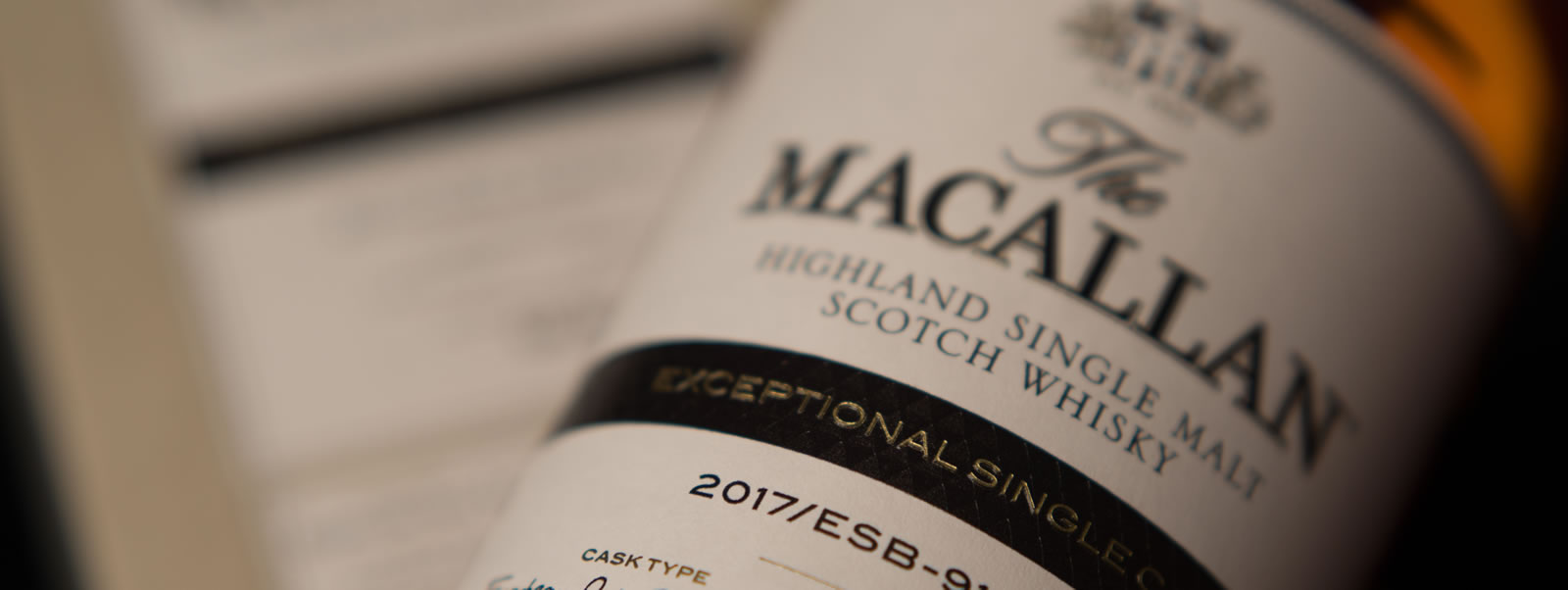LIMITED WHISKEY PRODUCTION, AND THE RESULTING SURGING PRICES, GRABBING THE ATTENTION OF IMBIBERS … AND COLLECTORS
By Debbie Carlson
Wine investing is well-established in the collecting world. Now it’s whiskey’s turn.
Storing Your Collection
While wine collections have certain storage requirements, storing a prized whiskey collection is generally much easier, because unlike wine, whiskey doesn’t age in the bottle.
Kieron Elliott, national accounts manager at Edrington, the group that owns Macallan, says there are a few basics to keep your investment intact for years to come. Store the bottle standing up, rather than lying on its side. Whiskey has a much higher alcohol content, at least 40 percent, and if the spirit is left laying down, it will eat through the cork. Avoid direct sunlight and ultraviolet light, which can damage labels and discolor the liquid.
Whiskey can be stored in a cool, dry place, but it’s also fine at room temperature, says Andy Simpson, founder of Rare Whisky 101. Avoid extreme temperatures, which causes the liquid to expand and contract, loosening the closures, which can lead to evaporation.
“As long as there’s a good closure on it, there’s no danger of it turning into vinegar,” Simpson says. “A whiskey with a good closure will outlast you and I.”
From an investment-risk perspective, Simpson adds, there are two “Ds” to keep in mind with Scotch: “Don’t drink it and don’t drop it.”
In the past decade, investing in whiskey (or, whisky, as the Scottish prefer) has grown in popularity, and prices have followed. In May, two bottles of a rare 60-year-old Macallan whiskey sold for more than $1 million – each – making them, at the time, the most expensive whiskies ever sold. The sale smashed the previous world-record price for a whiskey – also a Macallan bottle. “It’s quite incredible,” says Kieron Elliott, national accounts manager at Edrington, the group that owns Macallan.
The sale in November of a 60-year-old bottle of Macallan Valerio Adami 1926 single malt whiskey kept the pace going, selling for just over $1.1 million.
Enlarge

A bottle of whiskey selling for more than a million bucks is a standout, but prices for the noble spirit have grown sharply in recent years. The Rare Whisky Apex 1000 Index, which tracks the best-performing 1,000 rare whiskey bottles, is up 447 percent since 2010. Mike Raymond, owner of Reserve 101 and the Cottonmouth Club in Houston and a judge for Whiskies of the World, says whiskey has been undervalued for a long time, so it’s not surprising to see these price gains.
In the 1980s, when consumers preferred vodka, a number of Scottish distilleries closed, says Lorne Cousin, national brand ambassador for Balvenie. Tastes for whiskey came back in the late 1990s, but there were fewer distilleries to meet renewed demand. Considering that finer whiskies need to age for 10 to 12 years before being considered a basic bottling, it made an already-scarce product rarer.
INVESTOR INTEREST
Whiskey collecting has a strong investment case, says Andy Simpson, founder of Rare Whisky 101, and one of the world’s top experts. On the supply side, it’s a quality product and there’s a finite supply. Investors focus on single-malt whiskies from the most iconic Scottish distilleries such as Macallan, Balvenie, Ardbeg, Lagavulin, Glenmorangie and others, plus select distilleries from Japan. Single-malt whiskies comprise only 8 percent to 10 percent of all Scotch whisky production annually.
Enlarge

Demand comes from three overlapping categories: those who like to drink whiskey, those who collect certain types of bottles, and investors seeking to eventually sell collections. “Somebody’s collection today quite regularly becomes someone’s drink tomorrow,” Simpson says, “so there’s this great interaction between all three buyers.”
There are a number of ways to get started. Some collectors focus on a particular distillery. Others look for bottles from their birth year or an anniversary. For someone who wants a meaningful, instant collection, a buyer should start with at least $100,000 and work with a reputable whiskey merchant, Simpson says.
Look for limited-editions bottles, Raymond says, as the core lines of whiskey sold in your local liquor shops are unlikely to see a price jump. Start with specialized whiskey shops and auctions.
Travel is a popular way for people to collect whiskies, whether at duty-free shops or visiting their favorite distilleries to source distillery-only releases, says Clarke Boyer, brand ambassador for Glenmorangie and Ardbeg. “What companies have increasingly done is put out special releases just for travel retail. It’s a cool way to reward travelers and give them something that they can’t necessarily get elsewhere.”
TOP POURS
Macallan’s multiple limited-edition releases have helped the brand become the top collector’s whiskey, Elliot says. The distillery’s newest limited-edition bottling is the Exceptional Single Cask, released in late 2017; it’s a series of seven whiskies that initially retailed in the United States for $250 to $1,300. Cask 001, a 20-year-old that retailed at about $1,000, now fetches just under $24,000, he says. The distillery is about to release a new wave of these bottlings in the United States. Single-cask bottling isn’t something Macallan does often, making it unique. Additionally, he says the flavor of the bottling is “absolutely phenomenal.”
Another popular collectible whiskey is the Balvenie’s Tun series, which started when the distillery’s famed malt master, David Stewart, decided to play around with casks that dated to the 1980s whiskey slump. The series of nine bottles, Tun 1401, became hugely popular. Originally sold for about $250, a bottle can now command well over $1,000. A complete set of nine recently realized more than $20,000. Another highly prized collection, Cousin says, is Balvenie’s DCS Compendium, which celebrates Stewart’s 50-plus years of working at the distillery. There will be five “chapters” in the series – with three released already. Stewart selected 25 extremely rare and significant vintage single cask whiskies as part of the series. Cousin says Chapter 3, which was the oldest vintage released, at 55 years, sold for $60,000.
Whiskey collecting has similarities to wine collecting, Elliott says. Like wine, certain houses and certain labels are more desirable than others, but the biggest difference is whiskey is less volatile than wine if stored properly. Whiskey remains inert once bottled, while wine ages in the bottle. Geographical differences, Boyer says, may affect value in whiskey collecting, but unlike wine, whiskey isn’t influenced by seasons or harvests since distillers use somewhat commoditized grain products to create unique maturation characteristics.
Like any item that’s seen a sharp price increase, connoisseurs should be aware of counterfeiting, Simpson points out. He’s worked with brands and collectors on sniffing out fakes. They can be as obvious as poorly designed labels to as sinister as refilling real bottles with different whiskey or even tea. The best way to be sure is to radiocarbon test the liquid inside, he says.
For collectors seeking whiskey as an investment, experts say whiskies outside of Scotland, such as the Japanese whiskies Hanyu and Yamazaki, can have value, but demand for non-Scottish can be specialized. There’s some demand for select U.S. whiskies, and little demand for Canadian or Irish whiskies. “From a pricing perspective, we’ve seen continuous upward pricing pressure on Scotch,” Simpson says, “whereas with some Japanese whiskies, there tends to be not boom-and-bust, but boom and then stabilize.”
Whiskey demand has prompted some previously shuttered distilleries, such as the highly prized Port Ellen and Brora labels, to reopen. But Simpson doesn’t see the reopened distillers pressuring prices of old whiskies. “To see a 38- or a 40-year-old Port Ellen [from the new distillery],” he says, “we’re all going to be retired well before that.”
 DEBBIE CARLSON is a Chicago freelancer whose work has appeared in Barron’s, U.S. News & World Report and The Wall Street Journal.
DEBBIE CARLSON is a Chicago freelancer whose work has appeared in Barron’s, U.S. News & World Report and The Wall Street Journal.
This story appears in the Winter 2018-2019 edition of The Intelligent Collector magazine. Click here to subscribe to the print edition

